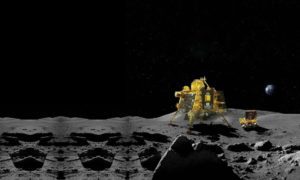Last month, as India said it achieved a milestone by landing its Chandrayaan-3 rover on the moon, making it the first country to place a spacecraft near the lunar south pole, a top Chinese scientist, Ouyang Ziyuan, who is celebrated as the father of China’s lunar exploration program, has contested India’s claims, Bloomberg reported.
Earlier, as India celebrated the landing success, the move surpassed China’s previous record for the southernmost lunar landing.
Ouyang Ziyuan stated in an interview with the Chinese-language Science Times newspaper that Chandrayaan-3’s landing site, located at 69 degrees south latitude, is not close to the actual lunar south pole.
On Earth, 69 degrees south would be within the Antarctic Circle, but on the moon, the lunar version of the circle is much closer to the pole. Ouyang argued that Chandrayaan-3 was 619 kilometers (385 miles) away from the lunar polar region, emphasizing that it did not constitute a landing at the lunar south pole.
The Indian Space Research Organisation (ISRO) has not yet responded to these claims.
Following the Chandrayaan-3 landing, Chinese space experts, such as Pang Zhihao quoted in the Global Times, suggested that China possessed superior technology in space exploration.
They highlighted China’s capability to send orbiters and landers directly into Earth-Moon transfer orbit since the launch of Chang’e-2 in 2010, a feat that India has not yet accomplished due to the limited capacity of its launch vehicles. Additionally, they claimed that China’s engine technology was more advanced.
Chandrayaan-3’s rover landed at a latitude of around 69 degrees south. Ouyang told the publication it was within the moon’s southern hemisphere but not the polar region, which he considered to be “between the latitudes of 88.5 and 90 degrees” South China Morning Post (SCMP) reported.
The Earth’s axis is tilted at around 23.5 degrees and accordingly, the southern pole is defined to be between 66.5 and 90 degrees south. Ouyang, however, argued that since the Moon’s tilt was only 1.5 degrees, the polar region was much smaller.
The publication also quoted Richard de Grijs, a professor at Macquarie University’s School of Mathematical and Physical Sciences in Sydney, who said that Chandrayaan-3 had landed in a region outside the lunar south pole.














